Prestress Force Monitoring and Quantification of Precast Segmental Beams through Neutral Axis Location Identification
Abstract
:1. Introduction
2. Theoretical Derivation
3. Experimental Verification
3.1. Description of the Experimental Beam
3.2. Experimental Testing
3.2.1. Post-Tensioning and Installed Strain Gauges
3.2.2. Loading Process
3.3. Experimental Results during the Post-Tensioning Process
3.3.1. Experimental Validation of the Proposed Approach to Quantify Prestress Force
3.3.2. Discussions
4. Numerical Verifications
4.1. Numerical Finite Element Model of this Precast Segmental Beam
4.2. Model Validation
5. Model Updating for the Segmental Beam
5.1. Parametric Sensitivity Analysis
5.2. Model Updating Based on the Measured Static Data
5.3. Numerical Simulations of Prestress Force Identifications by the Proposed Approach
5.4. Discussions
5.5. Prestress Force Quantification under the Dynamic Load
6. Conclusions
Author Contributions
Funding
Data Availability Statement
Acknowledgments
Conflicts of Interest
References
- Saiidi, M.; Douglas, B.; Feng, S. Prestress Force Effect on Vibration Frequency of Concrete Bridges. J. Struct. Eng. 1994, 120, 2233–2241. [Google Scholar] [CrossRef]
- Miyamoto, A.; Tei, K.; Nakamura, H.; Bull, J. Behavior of Prestressed Beam Strengthened with External Tendons. J. Struct. Eng. 2000, 126, 1033–1044. [Google Scholar] [CrossRef]
- Chan, T.; Yung, T. A theoretical study of force identification using prestressed concrete bridges. Eng. Struct. 2000, 22, 1529–1537. [Google Scholar] [CrossRef]
- Hamed, E.; Frostig, Y. Natural frequencies of bonded and unbonded prestressed beams—Prestress force effects. J. Sound Vib. 2006, 295, 28–39. [Google Scholar] [CrossRef]
- Dall’Asta, A.; Dezi, L. Discussion of “Prestress Force Effect on Vibration Frequency of Concrete Bridges” by M. Saiidi, B. Douglas and S. Feng. J. Struct. Eng. 1996, 122, 458. [Google Scholar] [CrossRef]
- Wang, T.; Huang, R.; Wang, T. The variation of flexural rigidity for post-tensioned prestressed concrete beams. J. Mar. Sci. Technol. 2013, 21, 300–308. [Google Scholar]
- Noble, D.; Nogal, M.; O’Connor, A.; Pakrashi, V. The effect of prestress force magnitude and eccentricity on the natural bending frequencies of uncracked prestressed concrete beams. J. Sound Vib. 2016, 365, 22–44. [Google Scholar] [CrossRef] [Green Version]
- Jang, J.; Lee, H.; Hwang, K.; Song, Y. A sensitivity analysis of the key parameters for the prediction of the prestress force on bonded tendons. Nucl. Eng. Technol. 2010, 42, 319–328. [Google Scholar] [CrossRef] [Green Version]
- Toyota, Y.; Hirose, T.; Ono, S.; Shidara, K. Experimental Study on Vibration Characteristics of Prestressed Concrete Beam. Procedia Eng. 2017, 171, 1165–1172. [Google Scholar] [CrossRef]
- Lu, Z.; Law, S. Identification of prestress force from measured structural responses. Mech. Syst. Signal Process. 2006, 20, 2186–2199. [Google Scholar] [CrossRef]
- Ho, D.; Kim, J.; Stubbs, N.; Park, W. Prestress-Force Estimation in PSC Girder Using Modal Parameters and System Identification. Adv. Struct. Eng. 2012, 15, 997–1012. [Google Scholar] [CrossRef]
- Xia, Y.; Hao, H.; Zanardo, G.; Deeks, A. Long term vibration monitoring of an RC slab: Temperature and humidity effect. Eng. Struct. 2006, 28, 441–452. [Google Scholar] [CrossRef]
- Xiang, Z.; Chan, T.; Thambiratnam, D.; Nguyen, T. Synergic identification of prestress force and moving load on prestressed concrete beam based on virtual distortion method. Smart Struct. Syst. 2016, 17, 917–933. [Google Scholar] [CrossRef]
- Anastasopoulos, D.; de Roeck, G.; Reynders, E. Influence of damage versus temperature on modal strains and neutral axis positions of beam-like structures. Mech. Syst. Signal Process. 2019, 134, 106311. [Google Scholar] [CrossRef]
- Peeters, B.; de Roeck, G. One-year monitoring of the Z24-Bridge: Environmental effects versus damage events. Earthq. Eng. Struct. Dyn. 2001, 30, 149–171. [Google Scholar] [CrossRef]
- Soman, R.; Majewska, K.; Mieloszyk, M.; Malinowski, P.; Ostachowicz, W. Application of Kalman Filter based Neutral Axis tracking for damage detection in composites structures. Compos. Struct. 2018, 184, 66–77. [Google Scholar] [CrossRef]
- Xia, Y.; Lei, X.; Wang, P.; Liu, G.; Sun, L. Long-term performance monitoring and assessment of concrete beam bridges using neutral axis indicator. Struct. Control Health Monit. 2020, 27, 12. [Google Scholar] [CrossRef]
- Sigurdardottir, D.; Glisic, B. Neutral axis as damage sensitive feature. Smart Mater. Struct. 2013, 22, 75030. [Google Scholar] [CrossRef]
- Sigurdardottir, D.; Glisic, B. Detecting minute damage in beam-like structures using the neutral axis location. Smart Mater. Struct. 2014, 23, 125042. [Google Scholar] [CrossRef]
- Xia, H. SHM-Based Condition Assessment of In-Service Bridge Structures Using Strain Measurement. Ph.D. Thesis, The Hong Kong Polytechnic University, Hong Kong, China, 2012. [Google Scholar]
- Abdel-Jaber, H.; Glisic, B. Monitoring of prestressing forces in prestressed concrete structures—An overview. Struct. Control Health Monit. 2019, 26, 8. [Google Scholar] [CrossRef] [Green Version]
- Le, T.; Pham, T.; Hao, H.; Li, H. Behavior of Precast Segmental Concrete Beams Prestressed with External Steel and CFRP Tendons. J. Compos. Constr. 2020, 24, 4020053. [Google Scholar] [CrossRef]
- Le, T.; Pham, T.; Hao, H.; Yuan, C. Performance of precast segmental concrete beams posttensioned with carbon fiber-reinforced polymer (CFRP) tendons. Compos. Struct. 2019, 208, 56–69. [Google Scholar] [CrossRef]
- Zhan, H.; Jiang, H.; Zhang, J.; Jiang, R. Condition Evaluation of an Existing T-Beam Bridge Based on Neutral Axis Variation Monitored with Ultrasonic Coda Waves in a Network of Sensors. Sensors 2020, 20, 3895. [Google Scholar] [CrossRef] [PubMed]
- Noguchi, T.; Tomosawa, F.; Nemati, K.; Chiaia, B.; Fantilli, A. A Practical Equation for Elastic Modulus of Concrete. ACI Struct. J. 2009, 106, 690–696. [Google Scholar]
- AS 1012.8.1; Methods of Testing Concrete—Method 8.1: Method for Making and Curing Concrete—Compression and Indirect Tensile Test Specimens. Standards Australia International Ltd.: Sydney, NSW, Australia, 2014.
- AS 1012.9; Methods of Testing Concrete—Method 9: Compressive Strength Tests—Concrete, Mortar and Grout Specimens. Standards Australia International Ltd.: Sydney, NSW, Australia, 2014.
- AS 3600:2018; Concrete Structures. Standards Australia International Ltd.: Sydney, NSW, Australia, 2018.
- Hattori, G.; Serpa, A. Contact stiffness estimation in ANSYS using simplified models and artificial neural networks. Finite Elem. Anal. Des. 2015, 97, 43–53. [Google Scholar] [CrossRef] [Green Version]
- Ren, W.; Fang, S.; Deng, M. Response Surface—Based Finite-Element-Model Updating Using Structural Static Responses. J. Eng. Mech. 2011, 137, 248–257. [Google Scholar] [CrossRef]


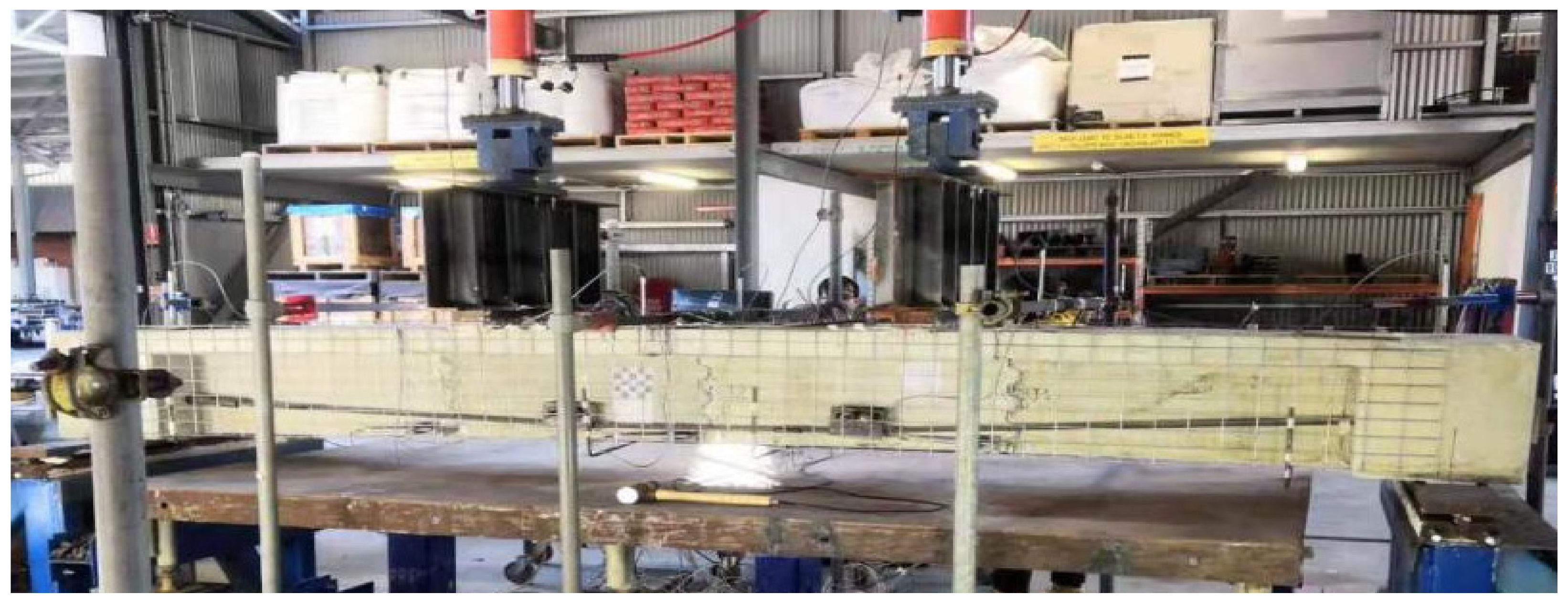
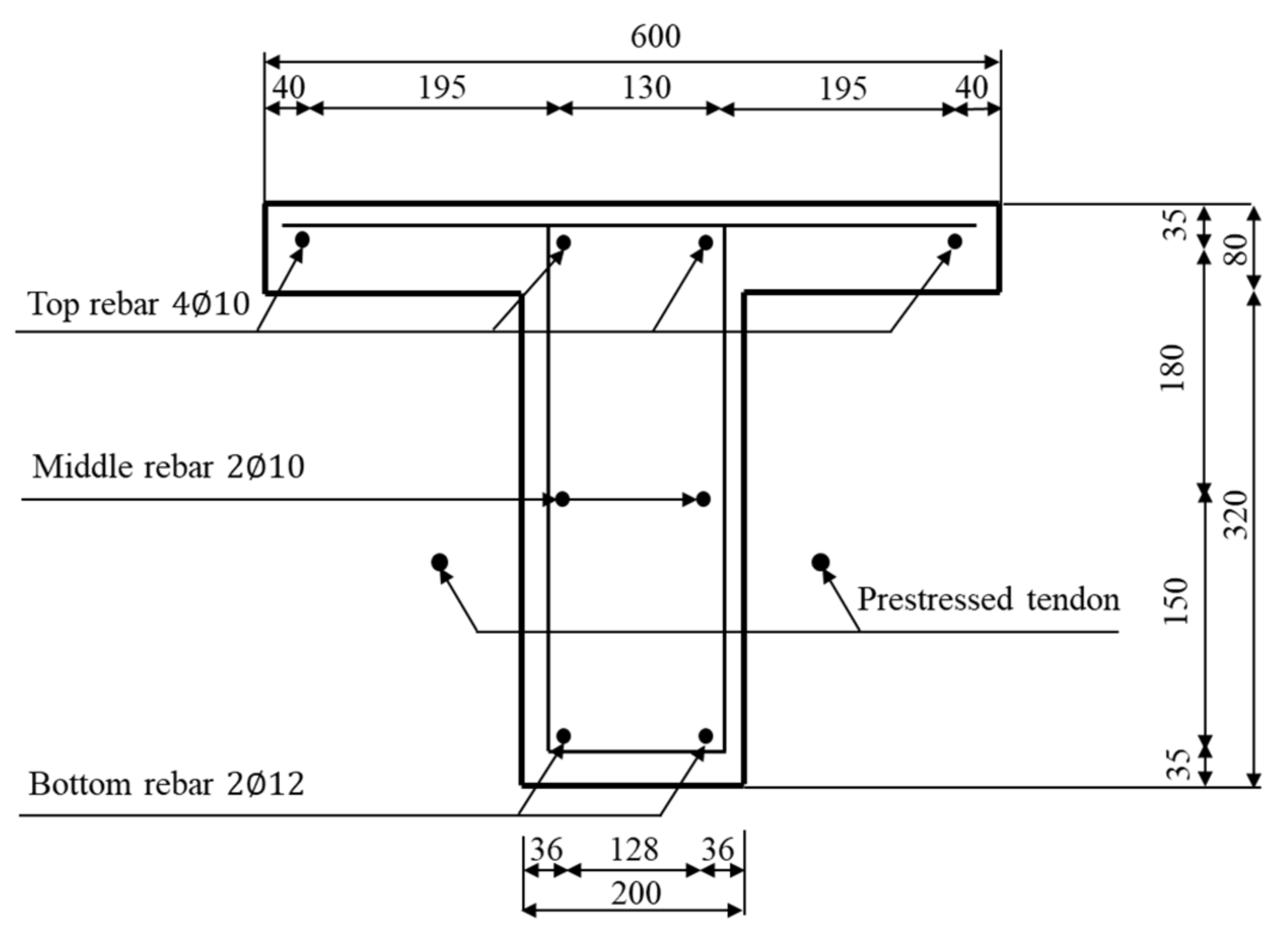
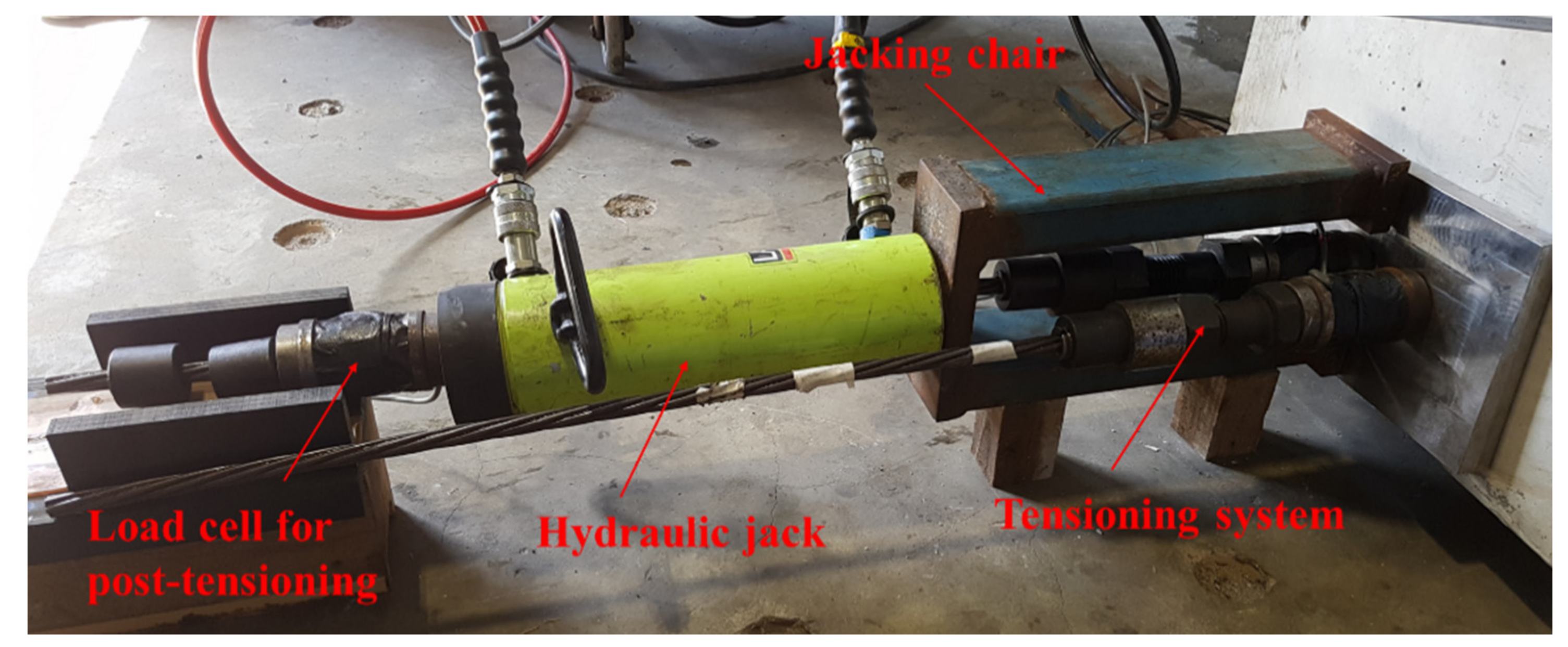

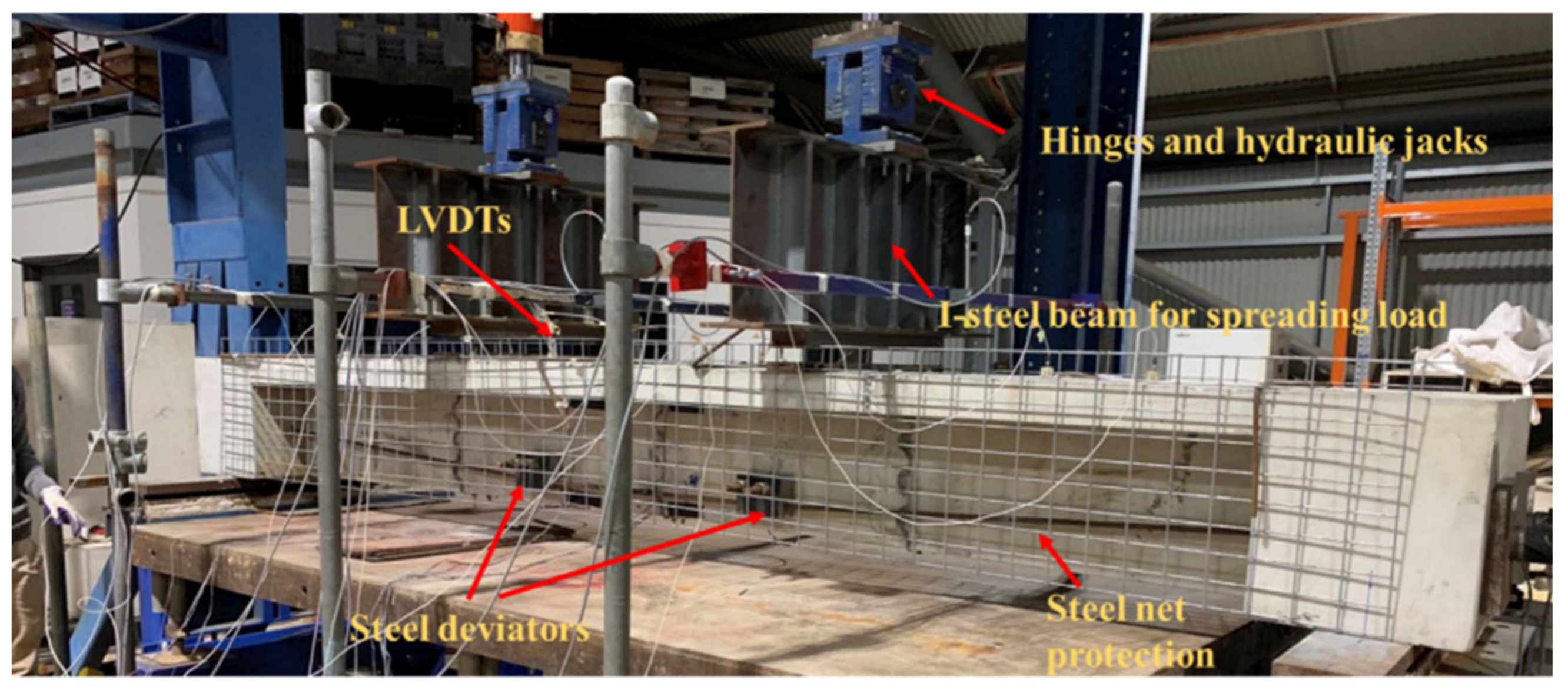
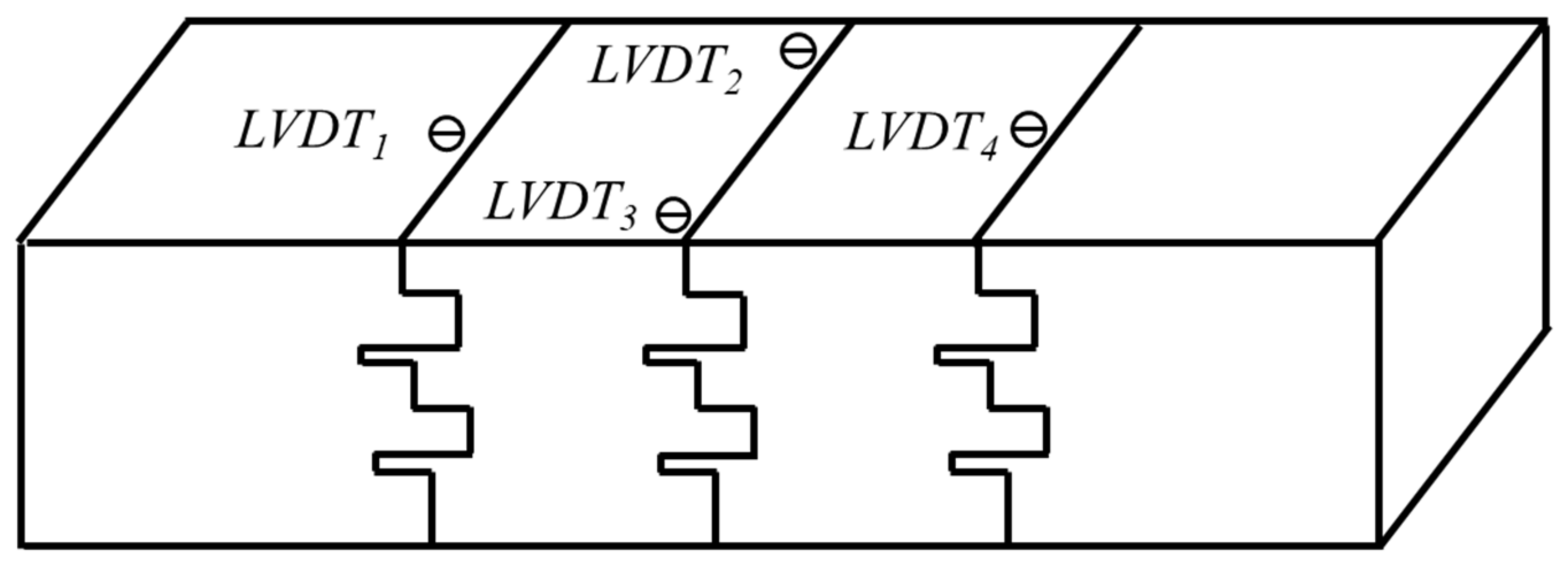
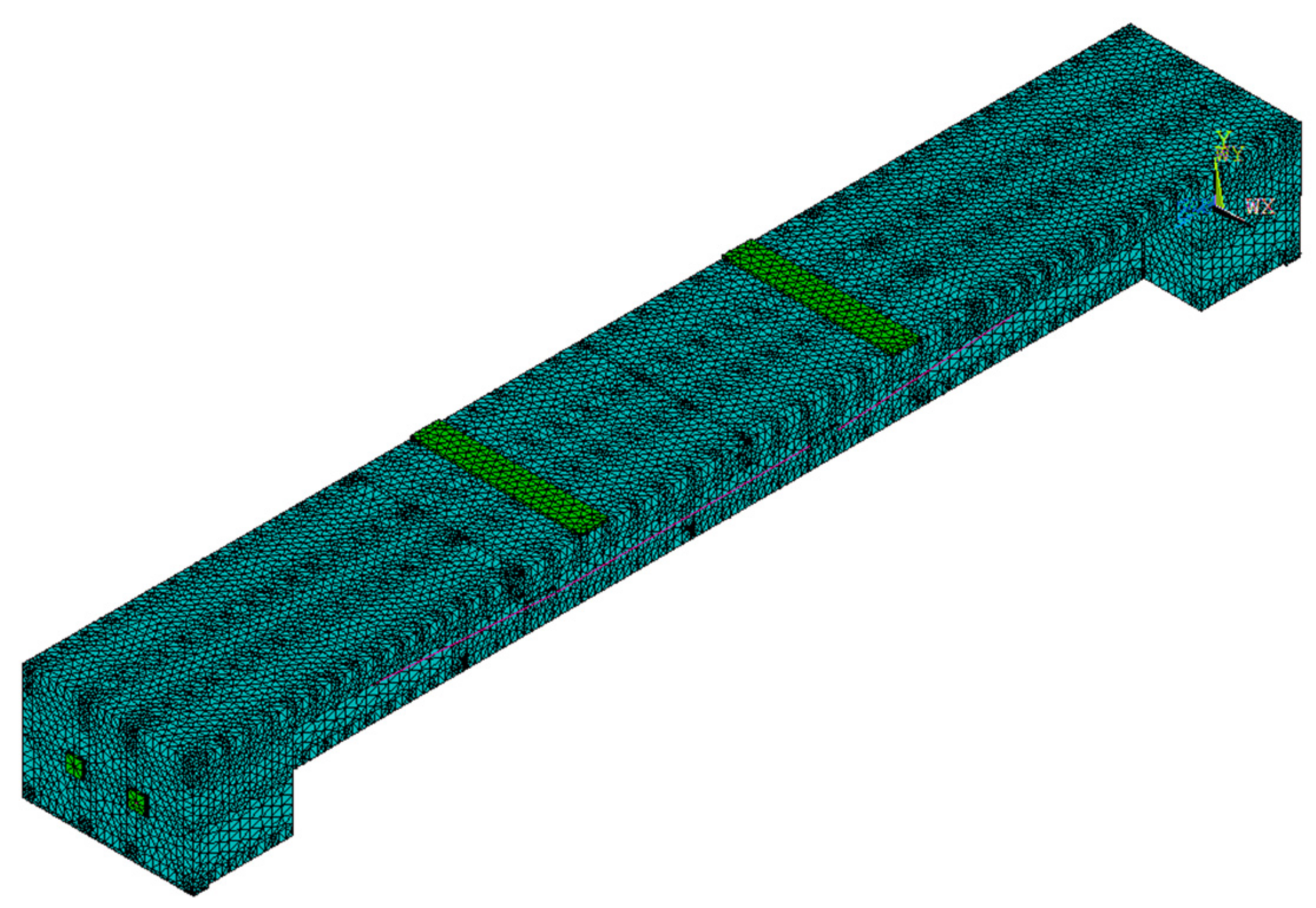
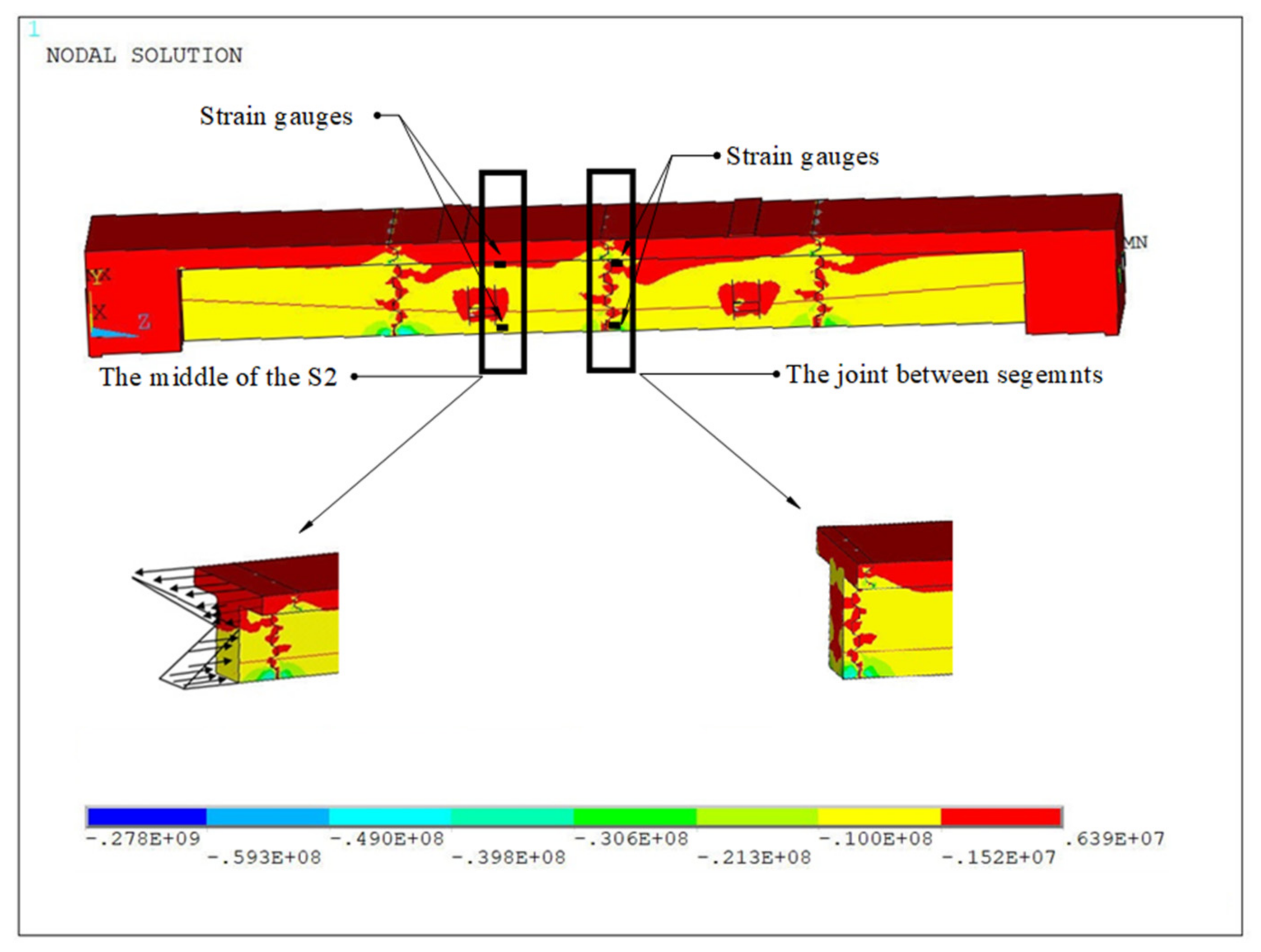
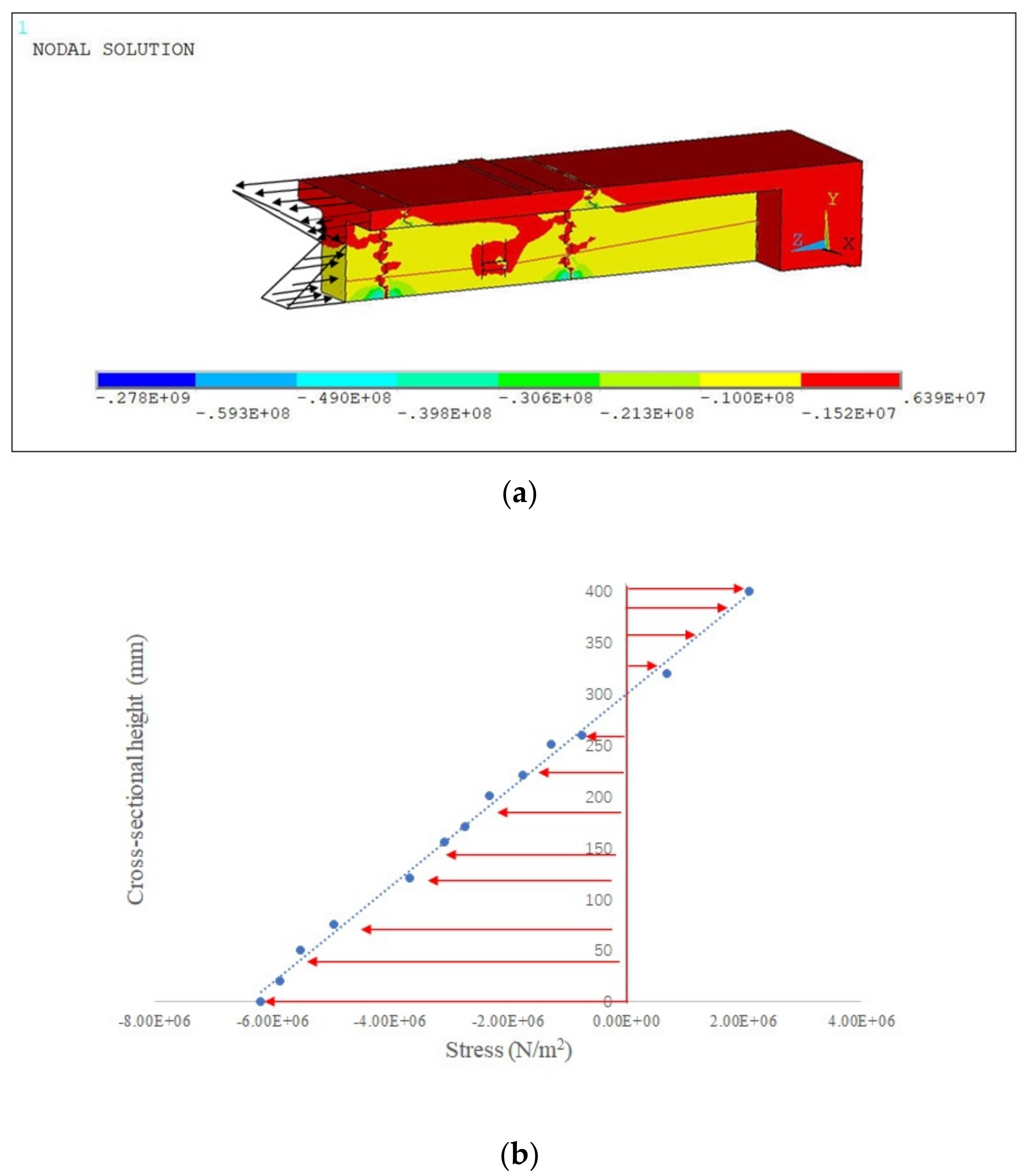
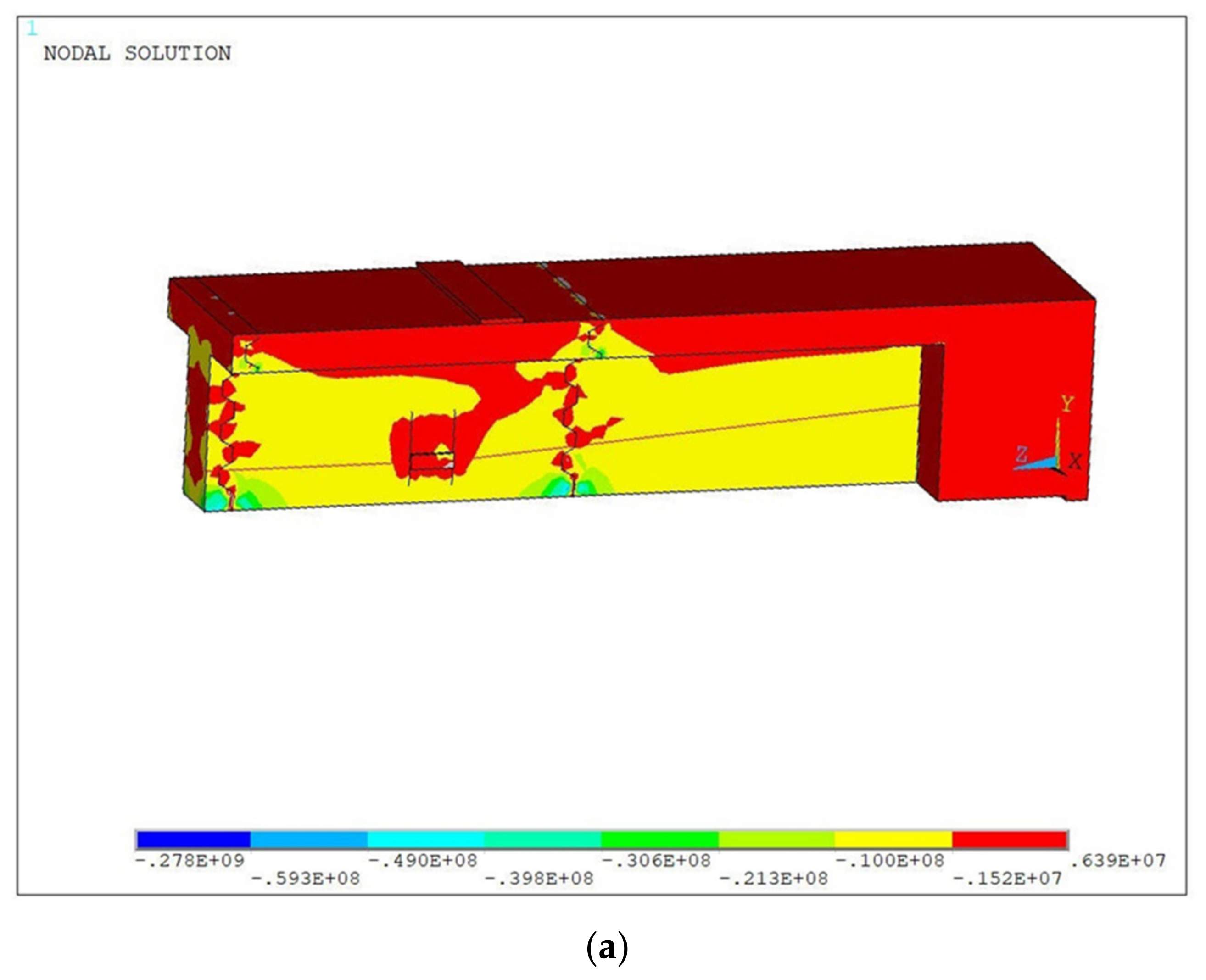
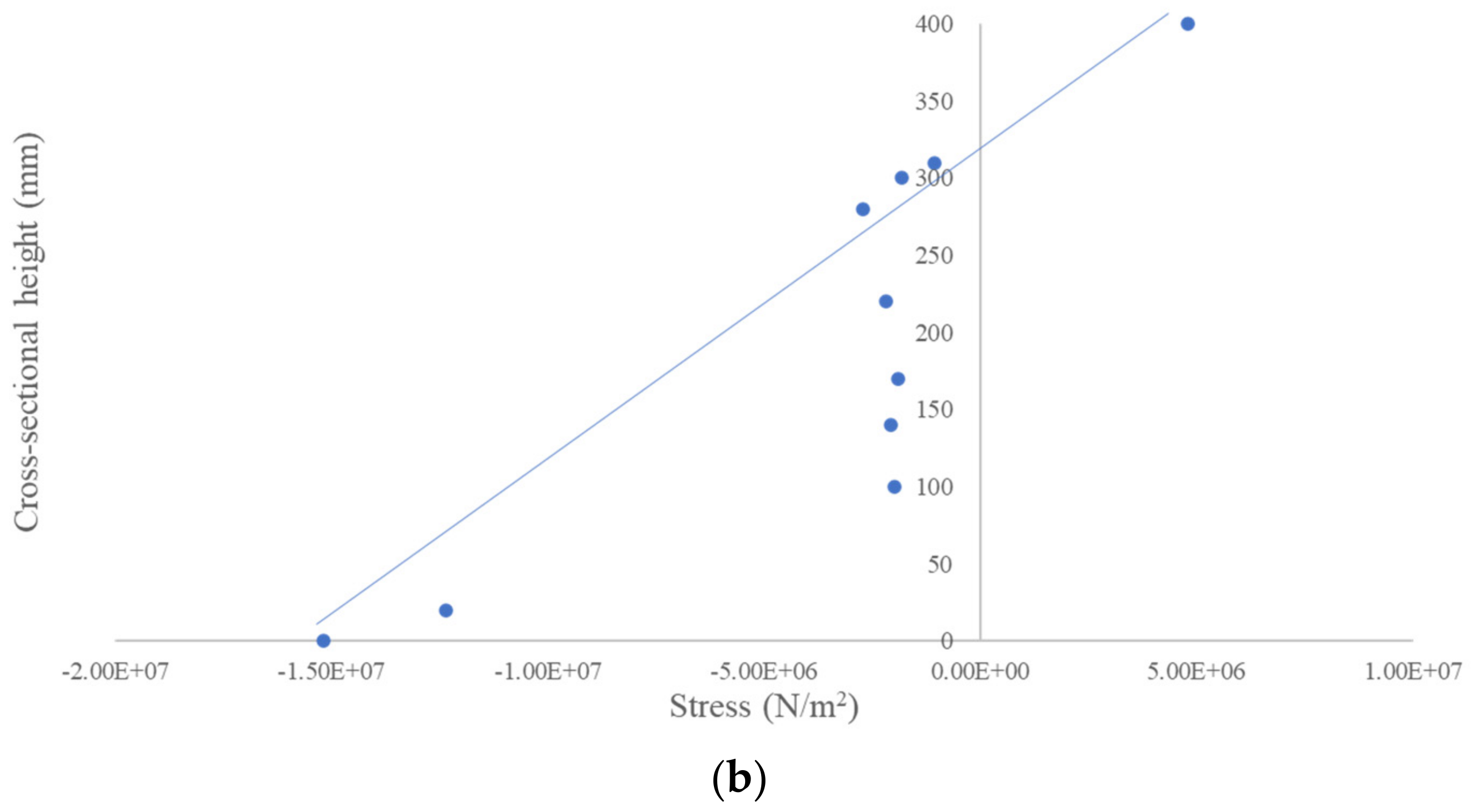
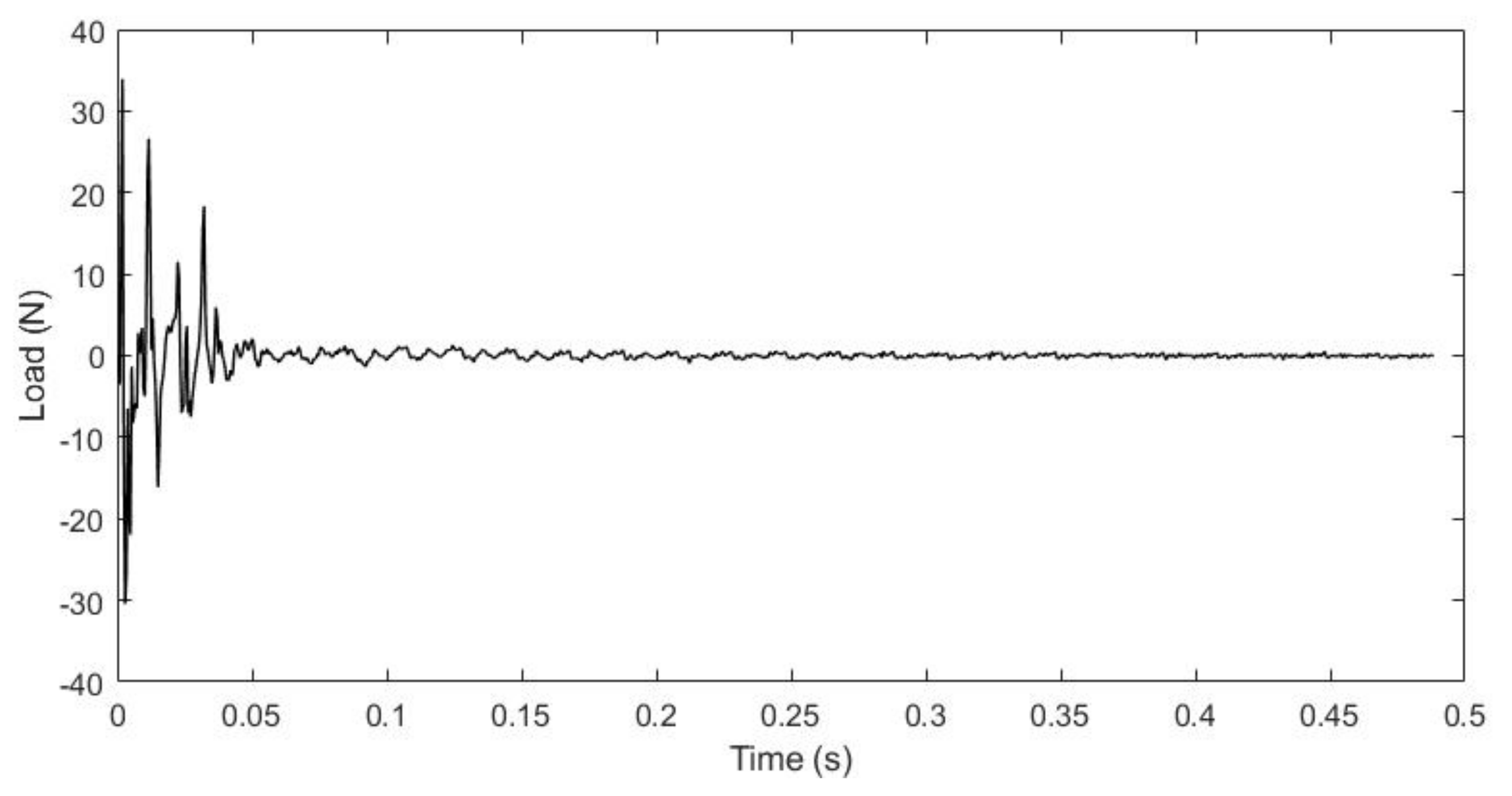
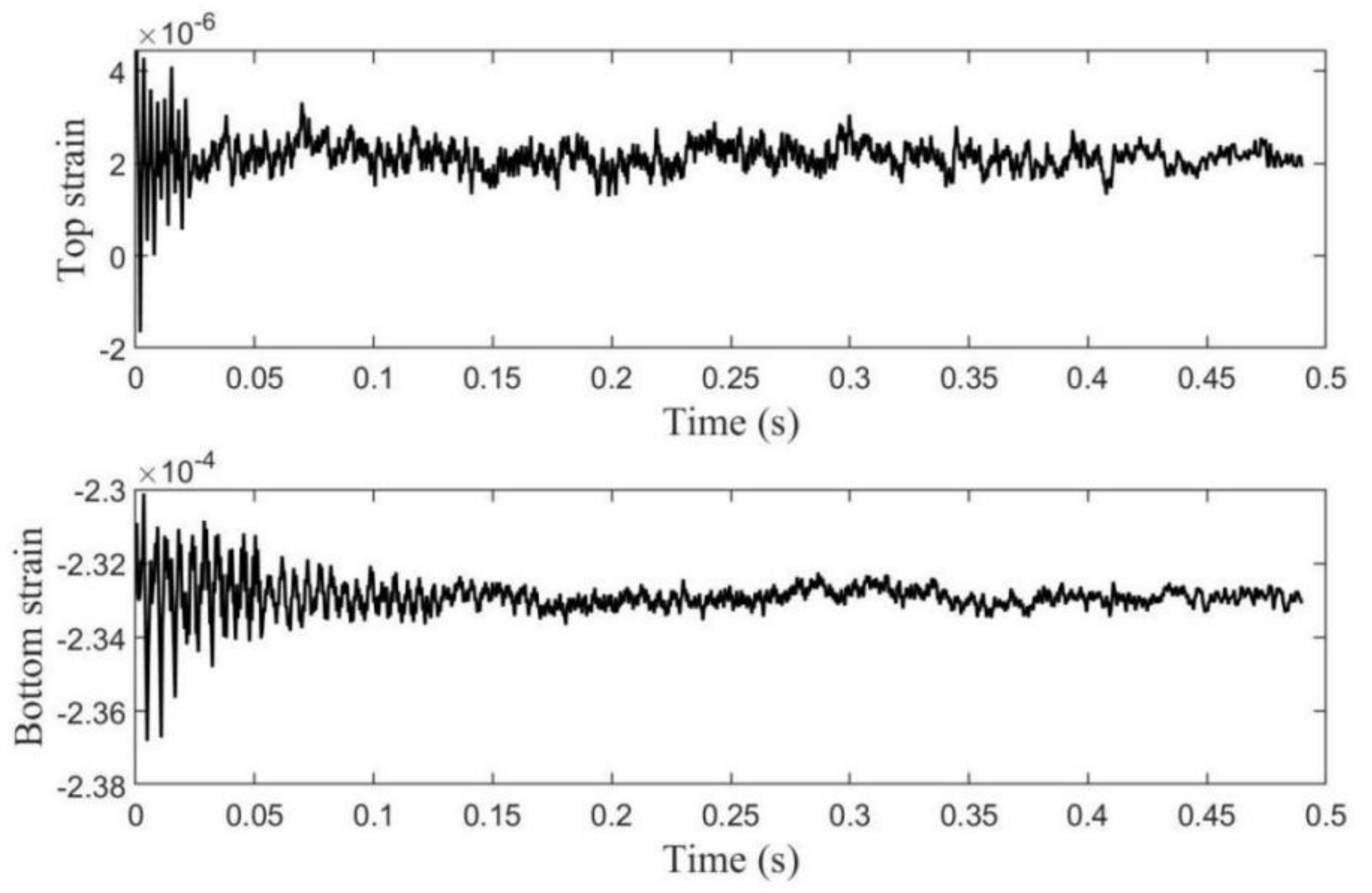
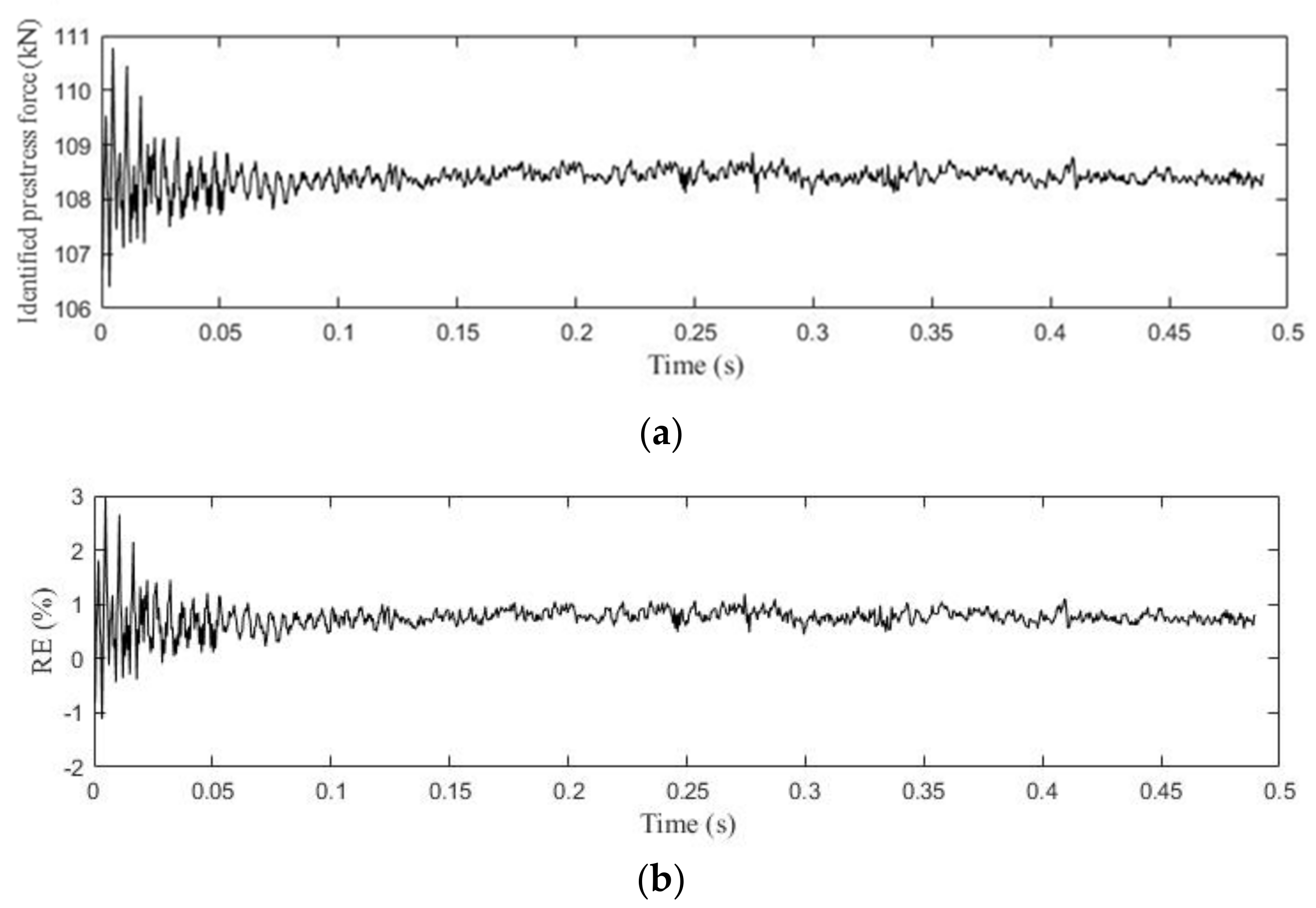
| Type | Diameter (mm) | Cross-Sectional Area (mm2) | Es (Gpa) | ||
|---|---|---|---|---|---|
| 12 | 113 | 534 | 587 | 200 | |
| 10 | 78.5 | 489 | 538 | 200 | |
| Prestressed Steel tendon | 12.7 | 100 | 1674 | 1860 | 195 |
| 305.05 | 61.57 | 64.17 | 4.22% | 314.72 | 61.57 | 70.93 | 15.20% |
| 297.54 | 107.11 | 108.7 | 1.48% | 303 | 107.11 | 119.72 | 11.77% |
| Variation | EC (Pa) | S2 | S3 | ||
|---|---|---|---|---|---|
| −20% | 2.438 × 1010 | −18.77% | −20.06% | −10.42% | −11.97% |
| −10% | 2.742 × 1010 | −7.86% | −9.29% | 1.65% | −0.09% |
| 10% | 3.352 × 1010 | 13.97% | 12.26% | 25.78% | 23.65% |
| 20% | 3.656 × 1010 | 24.88% | 23.03% | 37.85% | 36.52% |
| Original | 3.047 × 1010 | 3.06% | 1.48% | 13.72% | 11.77% |
| Uncertainty Error Level | S2 | S3 | ||
|---|---|---|---|---|
| 2% | 2.84 | 1.38 | 12.68 | 11.44 |
| 5% | 2.76 | 1.25 | 12.56 | 11.28 |
| 8% | 2.43 | 1.05 | 12.24 | 10.99 |
| Original | 3.06 | 1.48 | 13.72 | 11.77 |
| Prestress Force (kN) | ENAL2 (mm) | MNAL2 (mm) | RE (%) | ENAL3 (mm) | MNAL3 (mm) | RE (%) |
|---|---|---|---|---|---|---|
| 62 | 305.05 | 301.55 | −1.15% | 314.72 | 308.85 | −1.87% |
| 107 | 297.54 | 290.36 | −2.41% | 303 | 298.08 | −1.62% |
| RE (%) | RE (%) | RE (%) | |||||||
|---|---|---|---|---|---|---|---|---|---|
| 15 | −0.80 | −0.83 | 3.75 | −1.03 | −1.01 | −1.94 | −0.94 | −0.84 | −10.64 |
| 20 | −1.04 | −1.11 | 6.73 | −1.35 | −1.4 | 3.70 | −1.27 | −1.12 | −11.81 |
| Parameters | Changes of Parameters (%) | Sensitivity of Displacement Responses with Respect to the Parameter (%) | Sensitivity of Neutral Axis Location (%) | |||
|---|---|---|---|---|---|---|
| ML1 | ML23 | ML4 | MNAL2 | MNAL2 | ||
| 10 | 8.04 | 8.04 | 8.04 | 0.14 | 0.08 | |
| 10 | 1.38 | 1.40 | 1.37 | −0.18 | −0.03 | |
| 10 | −10.65 | −10.67 | −10.65 | 0.41 | 0.25 | |
| NSct | 10 | 2.02 | 2.06 | 2.15 | −0.01 | −0.02 |
| TSct | 10 | 0.00 | 0.00 | 0.00 | 0.04 | −0.01 |
| Parameters | |||
|---|---|---|---|
| Initial values | 3.047 × 1010 | 2450 | 1.95 × 1011 |
| Updated values | 3.045 × 1010 | 2625 | 2.05 × 1011 |
| Cases | Neural Axis Location | 15 kN | 20 kN | ||||||
|---|---|---|---|---|---|---|---|---|---|
| MNAL2 | MNAL3 | ML1 | ML23 | ML4 | ML1 | ML23 | ML4 | ||
| RE (%) | Original | −2.47 | −1.65 | 4.15 | 1.92 | 11.29 | 6.73 | 3.86 | 13.73 |
| Updated | 0.49 | −0.15 | −3.39 | −0.96 | 1.25 | −3.49 | −3.55 | 4.9 | |
| Cases | Neural Axis Location | ||
|---|---|---|---|
| MNAL2 | MNAL3 | ||
| RE (%) | Original | −1.16 | −1.90 |
| Updated | 0.99 | 1.34 | |
| Applied Prestress Force (kN) | TF2 (kN) | RE (%) | TF3 (kN) | RE (%) |
|---|---|---|---|---|
| 62 | 59.95 | −3.31% | 65.10 | 5.00% |
| 70 | 69.10 | −1.29% | 77.95 | 11.36% |
| 80 | 80.21 | 0.26% | 91.18 | 13.98% |
| 90 | 92.52 | 2.80% | 103.39 | 14.88% |
| 107 | 109.18 | 2.04% | 118.27 | 10.53% |
| Applied Prestress Force in the Numerical Model (kN) | Identified Average Prestress Force (kN) | Relative Error (%) |
|---|---|---|
| 107 | 108.41 | 1.32 |
Publisher’s Note: MDPI stays neutral with regard to jurisdictional claims in published maps and institutional affiliations. |
© 2022 by the authors. Licensee MDPI, Basel, Switzerland. This article is an open access article distributed under the terms and conditions of the Creative Commons Attribution (CC BY) license (https://creativecommons.org/licenses/by/4.0/).
Share and Cite
Li, H.; Li, J.; Xin, Y.; Hao, H.; Le, T.D.; Pham, T.M. Prestress Force Monitoring and Quantification of Precast Segmental Beams through Neutral Axis Location Identification. Appl. Sci. 2022, 12, 2756. https://doi.org/10.3390/app12052756
Li H, Li J, Xin Y, Hao H, Le TD, Pham TM. Prestress Force Monitoring and Quantification of Precast Segmental Beams through Neutral Axis Location Identification. Applied Sciences. 2022; 12(5):2756. https://doi.org/10.3390/app12052756
Chicago/Turabian StyleLi, Han, Jun Li, Yu Xin, Hong Hao, Tan D. Le, and Thong M. Pham. 2022. "Prestress Force Monitoring and Quantification of Precast Segmental Beams through Neutral Axis Location Identification" Applied Sciences 12, no. 5: 2756. https://doi.org/10.3390/app12052756
APA StyleLi, H., Li, J., Xin, Y., Hao, H., Le, T. D., & Pham, T. M. (2022). Prestress Force Monitoring and Quantification of Precast Segmental Beams through Neutral Axis Location Identification. Applied Sciences, 12(5), 2756. https://doi.org/10.3390/app12052756







